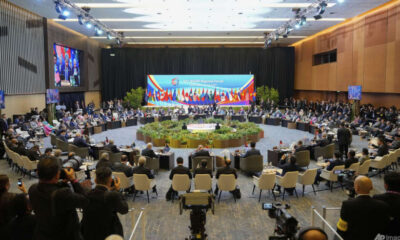Politics
Bangladesh Scraps Indian Economic Zone Project Amid Lack of Progress

When Prime Minister Narendra Modi proposed an Indian Economic Zone in Bangladesh during his visit to Dhaka in June 2015, the initiative was met with optimism. The then-Bangladeshi Prime Minister Sheikh Hasina agreed to the plan, leading to a joint declaration aimed at boosting Indian investments. Initial discussions centered on sites in Mongla or Rampal, with proposals for land ranging from 100 to 300 acres. By 2017, plans expanded significantly to encompass over 1,000 acres in Mirsarai, although this was later adjusted to approximately 900 acres, to be developed in collaboration with India’s Adani Group.
Mirsarai’s location is strategically important, acting as a corridor that links Chattogram, Cox’s Bazar, and Bangladesh’s hill districts. Concerns arose as the area was also considered for naval infrastructure, leading to anxiety over the implications of allocating land to a foreign economic zone. The Bangladesh Economic Zone Authority (BEZA) signed a memorandum of understanding with Adani Ports & SEZ (APSEZ) in October 2019, intending to develop the zone within the larger Bangabandhu Sheikh Mujib Shilpa Nagar (BSMSN), a flagship industrial city covering 30,000 acres.
Despite initial enthusiasm, the project stagnated. In April 2022, a joint-venture term sheet was finalized, with India backing the initiative with $115 million from its third Line of Credit (LoC). However, these funds were tied to strict conditions requiring a minimum of 75% of the contract value to be sourced from Indian firms, creating a significant barrier for local Bangladeshi firms to participate. This financing structure ultimately limited competition and raised project costs.
Despite requests from BEZA for the Exim Bank of India to allow Bangladeshi firms to bid on core land development works, these pleas went unanswered. Consequently, the only two prequalified companies, APSEZ and International Seaport Dredging, withdrew before the February 28, 2024, deadline. This left BEZA without bidders and effectively froze the project.
Under BEZA’s framework, economic-zone plots are leased, not sold, retaining sovereign title with the Bangladeshi state. Yet, having 900 acres of valuable industrial land locked under terms that stifled local involvement and competition yielded no tangible development. By mid-2024, the Indian Economic Zone had not moved beyond paperwork, and the tender for land development had collapsed. Other zones within BSMSN, free from such constraints, saw new tenants and began construction on their facilities.
In May 2025, Bangladesh’s investment chief succinctly stated, “The Indian Economic Zone exists only on paper.” This verdict underscores the fundamental flaws in the design of the project. Three major issues contributed to its failure.
First, the financing model was vendor-tied. The requirement for 65–75% of contract value to be sourced from India eliminated competitive pressure, inflated costs, and created a dependency cycle for Bangladesh. Second, branding the zone as exclusive to one country limited potential investors. When the prequalified firms withdrew, alternatives were scarce, highlighting the need for a sector-focused, country-neutral model that could attract a broader range of investors. Third, the lack of transparency in the process led to delays. Milestones slipped without enforcement, leaving the project mired in uncertainty.
Moving forward, Bangladesh needs a pragmatic approach to re-energize the stalled 900 acres. By eliminating the country-specific designation and repositioning the land as a specialized industrial zone—targeting sectors like electronics, automotive components, or renewable energy—the government could stimulate interest from both local and foreign developers. This would be supported by stringent use-it-or-lose-it clauses, ensuring accountability and progress.
The financing structure must also be revisited. Concessional credit should facilitate fair competition; if India cannot adjust its sourcing thresholds, Bangladesh should seek neutral financing options from multilateral institutions or alternative partners. To build trust and ensure accountability, the government should make the terms of joint venture governance, procurement rules, and development schedules publicly available. Importantly, measures must be implemented to mandate domestic subcontracting, workforce training, and technology transfer—ensuring that industrialization benefits Bangladesh’s economy rather than simply outsourcing jobs.
The case of the Mirsarai Indian Economic Zone serves as a cautionary tale for host countries in the Global South. The combination of country-specific zones and vendor-tied credit can create a trap that stifles local economic development. Sovereign title on paper does not translate to real benefits when foreign firms control contracts and financing.
Bangladesh’s broader economic zone strategy remains viable, as demonstrated by BSMSN’s success in attracting a diverse range of tenants through competitive infrastructure and regulatory clarity. The contrast between these successes and the stalled Indian Economic Zone highlights the importance of openness, competition, and accountability in future endeavors.
As the project dissolves into history, Bangladesh’s challenge is to realign its land, financing, and political frameworks to promote its own economic diversification rather than cater to the export ambitions of neighboring countries.
-

 Lifestyle3 months ago
Lifestyle3 months agoHumanism Camp Engages 250 Youths in Summer Fest 2025
-

 Sports3 months ago
Sports3 months agoDe Minaur Triumphs at Washington Open After Thrilling Comeback
-

 Business4 months ago
Business4 months agoKenvue Dismisses CEO Thibaut Mongon as Strategic Review Advances
-

 Sports4 months ago
Sports4 months agoTupou and Daugunu Join First Nations Squad for Lions Clash
-

 Top Stories4 months ago
Top Stories4 months agoColombian Senator Miguel Uribe Shows Signs of Recovery After Attack
-

 World4 months ago
World4 months agoASEAN Gears Up for Historic Joint Meeting of Foreign and Economic Ministers
-

 Business4 months ago
Business4 months agoOil Prices Surge Following New EU Sanctions on Russia
-

 Health3 months ago
Health3 months agoNew Study Challenges Assumptions About Aging and Inflammation
-

 Entertainment3 months ago
Entertainment3 months agoDetaşe-Sabah Violin Ensemble Captivates at Gabala Music Festival
-

 Entertainment3 months ago
Entertainment3 months agoBaku Metro Extends Hours for Justin Timberlake Concert
-

 Business4 months ago
Business4 months agoU.S. House Approves Stablecoin Bill, Sends to Trump for Signature
-

 Top Stories4 months ago
Top Stories4 months agoRethinking Singapore’s F&B Regulations Amid Business Closures









